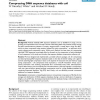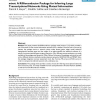BMCBI
2008
13 years 11 months ago
2008
Background: Genome survey sequences (GSS) offer a preliminary global view of a genome since, unlike ESTs, they cover coding as well as non-coding DNA and include repetitive region...
BMCBI
2008
13 years 11 months ago
2008
Background: Publicly available DNA sequence databases such as GenBank are large, and are growing at an exponential rate. The sheer volume of data being dealt with presents serious...
BMCBI
2008
13 years 11 months ago
2008
BMCBI
2008
13 years 11 months ago
2008
Background: Microarray gene expression data are often analyzed together with corresponding physiological response and clinical metadata of biological subjects, e.g. patients'...
BMCBI
2008
13 years 11 months ago
2008
Background: The local connectivity and global position of a protein in a protein interaction network are known to correlate with some of its functional properties, including its e...
BMCBI
2008
13 years 11 months ago
2008
BMCBI
2008
13 years 11 months ago
2008
Background: High-throughput genome biological experiments yield large and multifaceted datasets that require flexible and user-friendly analysis tools to facilitate their interpre...
BMCBI
2008
13 years 11 months ago
2008
Background: We consider the discovery of recombinant segments jointly with their origins within multilocus DNA sequences from bacteria representing heterogeneous populations of fa...
BMCBI
2008
13 years 11 months ago
2008
Background: The Baum-Welch learning procedure for Hidden Markov Models (HMMs) provides a powerful tool for tailoring HMM topologies to data for use in knowledge discovery and clus...
BMCBI
2008
13 years 11 months ago
2008
Background: Protein remote homology detection and fold recognition are central problems in bioinformatics. Currently, discriminative methods based on support vector machine (SVM) ...


